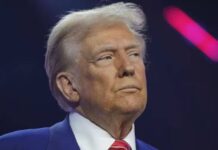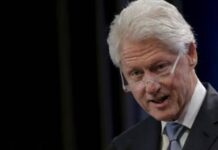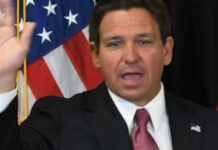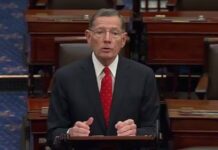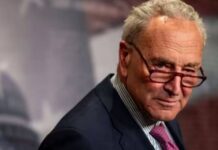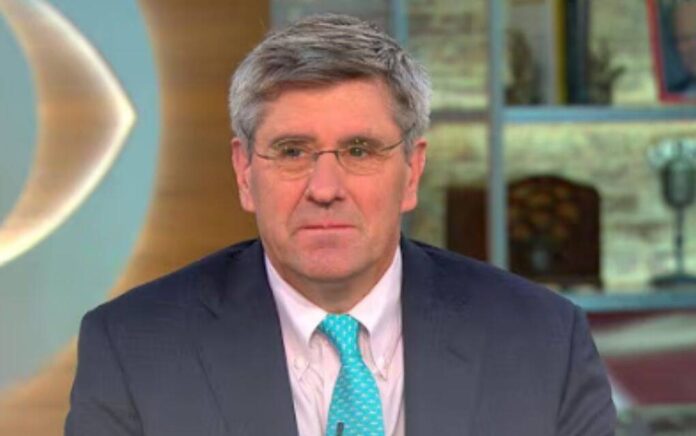
The Trump admin isn’t playing by the Swamp rule book. They’re going back to common sense.
And now a top economist simply can’t believe what the Trump admin’s done in this latest report.
Economist Steve Moore shared his excitement over the latest U.S. real gross domestic product (GDP) figures during an appearance on “The Charlie Kirk Show.” The U.S. Bureau of Economic Analysis (BEA) reported that GDP grew at an annual rate of 3.0% in the second quarter of 2025, driven by a decline in imports and a rise in consumer spending. Moore attributed this growth to the economic policies of President Donald Trump.
“Oh my gosh, what a day. I cannot believe these numbers that came out today, Charlie. Trump is just hitting it out of the park,” Moore told host Charlie Kirk. “And do you remember five months ago when all the leftists said, ‘Oh, Trump is going to cause a second Great Depression. He’s going to destroy the economy and the stock market’s gonna crash.’”
“We got the news today of 3% economic growth for the second quarter,” he continued. “That’s higher than any quarter, I believe, in the four years that [Joe] Biden was president. This economy is cooking right now.”
According to Trading Economics, GDP growth exceeded 3% several times during the Biden administration. The recent 3% increase in Q2 2025 represents a recovery from a 0.5% decline in the first quarter, as reported by the BEA. Despite predictions that Trump’s tariff policies would spike inflation, various economic indicators, including a robust stock market hitting all-time highs, suggest otherwise.
The Federal Reserve Board noted a 0.1% rise in manufacturing output in June, following a revised 0.3% increase in May. Additionally, Reuters reported a 4,000-drop in U.S. jobless claims for the week ending July 19, marking six consecutive weeks of declines and a three-month low. Retail sales also exceeded expectations, growing by 0.6% in June, according to the U.S. Census Bureau’s advance estimates released on July 17.
Trump’s second term has seen the announcement of major trade agreements with the European Union, Japan, and the Philippines. On a Monday episode of his “Club Random” podcast, comedian Bill Maher acknowledged his incorrect prediction that Trump’s tariffs would devastate the economy by July.
“[T]he stock market is at record highs. I know not everybody lives by the stock market, but I also drive around. I don’t see a country in a depression at all,” he said. “I see people out there just living their lives. And I would have thought — and I gotta own it — that these tariffs were going to fucking sink this economy by this time — and they didn’t.”
In May, Moore also admitted on “Kudlow” that the anticipated inflation from Trump’s tariffs had not occurred. “I’ve been wrong. I thought these tariffs would cause higher inflation. Tariffs are taxes, and consumers bear some of the cost of that, but it just isn’t showing up in the numbers right now,” Moore told Fox Business host Larry Kudlow. “It just really isn’t and if you look at any, almost any measure of inflation right now, it’s pretty tame.”
The economic policies of the Trump administration, particularly its focus on deregulation and fairer trade deals, have contributed to a resilient U.S. economy in 2025, defying earlier predictions of economic downturns. Deregulation has been a cornerstone of Trump’s agenda, aimed at reducing bureaucratic hurdles and fostering business growth. By streamlining regulations, the administration has lowered compliance costs for businesses, enabling them to invest in expansion, innovation, and job creation. The 3.0% GDP growth in Q2 2025, as reported by the BEA, reflects the positive impact of these policies, with consumer spending and reduced imports driving economic activity.
Deregulation has particularly benefited small and medium-sized enterprises, which often face disproportionate burdens from regulatory compliance. By easing restrictions in sectors such as energy, manufacturing, and finance, the administration has created an environment conducive to investment and productivity. The Federal Reserve’s report of a 0.1% increase in manufacturing output in June 2025 notes this trend, following a 0.3% rise in May. These gains suggest that businesses are capitalizing on a less restrictive regulatory framework to boost production and efficiency.
The administration’s trade policies, centered on securing fairer deals, have also played a significant role. Trump’s tariffs, initially criticized for their potential to increase consumer prices, have instead pressured trading partners to negotiate more equitable agreements. New trade deals with the European Union, Japan, and the Philippines have opened markets for American goods while protecting domestic industries. These agreements aim to reduce trade deficits and promote U.S. exports, contributing to the decline in imports noted in the BEA’s GDP report.
Contrary to expectations, inflationary pressures from tariffs have remained subdued. As Steve Moore noted on “Kudlow,” inflation metrics have stayed relatively tame, suggesting that businesses and consumers have adapted to the tariff environment without significant price spikes. This resilience is further evidenced by the stock market’s record highs, which reflect investor confidence in the administration’s economic strategy. The absence of widespread inflation indicates that supply chains have adjusted, and domestic production has filled gaps left by reduced imports.
The labor market has also shown strength under these policies. The six-week decline in jobless claims, reaching a three-month low by July 19, 2025, highlights the economy’s ability to generate employment opportunities. Deregulation has encouraged hiring by reducing operational costs for businesses, while trade deals have supported job creation in export-driven industries. The 0.6% rise in retail sales in June, as reported by the U.S. Census Bureau, further indicates robust consumer confidence, a critical driver of economic growth.
Historical data from Trump’s first term provides additional context. Between 2017 and 2020, deregulation efforts, such as the rollback of over 20,000 pages of federal regulations, saved businesses billions annually, according to the Council of Economic Advisers. These savings translated into increased investment and job growth, with unemployment reaching a 50-year low of 3.5% in 2019. The current administration has built on this foundation, with updated trade policies enhancing global competitiveness.


